
Let the Light of Freedom Shine
A travel diary of Marquette’s 2023 Civil Rights Pilgrimage
When studying history, it’s important to keep in mind that change was never certain or inevitable. It can be easy to fall into the familiar rhythm of one thing led to another led to another, as if no alternative outcome was possible. Recognizing this bias is crucial to grasping the stakes and significance of the US Southern Civil Rights Movement.
The Civil Rights Movement — a seemingly inevitable thread of the American story — was never guaranteed. It took the unparalleled courage, organizing, and resistance of more people and communities than history books can mention. These persistent protests for freedom, dignity, and justice changed the trajectory of the nation.
In I’ve Got the Light of Freedom, Charles Payne writes that the Civil Rights Movement had two distinct traditions. First, the community-mobilizing tradition, which focused on large-scale, relatively short-term public events (such as campaigns of Dr. Martin Luther King, Jr. and the Southern Christian Leadership Conference or SCLC).
Second and lesser known, the community organizing tradition focused on the long-term development of leadership in ordinary men and women (such as the Mississippi movement and campaigns of the Student Nonviolent Coordinating Committee or SNCC).
With the above context guiding our 2023 Civil Rights Pilgrimage, we focused more intimately on the figures, organizations, and campaigns that propelled the Civil Rights Movement in Mississippi during this historic era. To make so many changes to our itinerary after the positive feedback last year was a risk, but it proved to be one worth taking.
“I can’t thank you all enough for the experience of a lifetime, and for a journey and relationships that have made an immeasurable impact on my life. This was more than I ever could have expected.”
Day 1: To the South
Saturday morning marked the first day of Marquette’s spring break and the first day of our pilgrimage. We loaded up our rental SUVs and began the journey to Memphis, TN, which included a dinner stop to watch Marquette Men’s Basketball win the Big East Tournament for the first time in school history.

Along the drive, we listened to episodes from season three of the Southern Poverty Law Center’s Teaching Hard History podcast (Ep1: Reframing the Movement and Ep2: Beyond the Master Narrative) and songs from our Civil Rights Pilgrimage Mix.
Day 2: Memphis and Mound Bayou
Our educational experience began with visits to two vastly different museums: one of the largest and most well-known Civil Rights museums and a small, relatively obscure museum in the Mississippi Delta.
National Civil Rights Museum at the Lorraine Motel
Located at the site where Dr. Martin Luther King, Jr. was assassinated, the National Civil Rights Museum provides an overview of the Black freedom struggle through expansive exhibits that cover enslavement, reconstruction, Jim Crow, and the Civil Rights Movement.


Two of the most striking exhibits here feature the most popular figures of the movement. We walked through a 1950’s-era bus that included a statue of Rosa Parks and the history of the Montgomery Bus Boycott. The final exhibit took us through the room Dr. King was staying in at the Lorraine Motel and the balcony where he was killed.
“This museum does an unparalleled job of placing events in time, and giving a fuller understanding to the history we witness.”
The exhibits focused primarily on catalyzing events and the community-mobilizing tradition — Brown v. Board of Education, the Montgomery Bus Boycott, the Nashville Sit-Ins, the Freedom Rides, the Birmingham campaign, the March on Washington, Freedom Summer, the Selma to Montgomery March, and the Memphis Sanitation Strike.



Mound Bayou Museum of African American History and Culture
The Mound Bayou Museum of African American History and Culture showcased the significance and development of Mound Bayou, an independent Black municipality. The town was founded in 1887 by Isaiah T. Montgomery and Benjamin T. Green, who were formerly enslaved by Joe Davis, the brother of Jefferson Davis.


Throughout its history, Mound Bayou was a haven for Black people in the middle of a state which brimmed with racial terror. Its early days included the development of numerous Black-owned businesses and successful farms. When the Taborian Hospital opened in 1942, Dr. T.R.M. Howard came to town, and beyond his duties as chief surgeon was a prominent entrepreneur and civil rights pioneer.

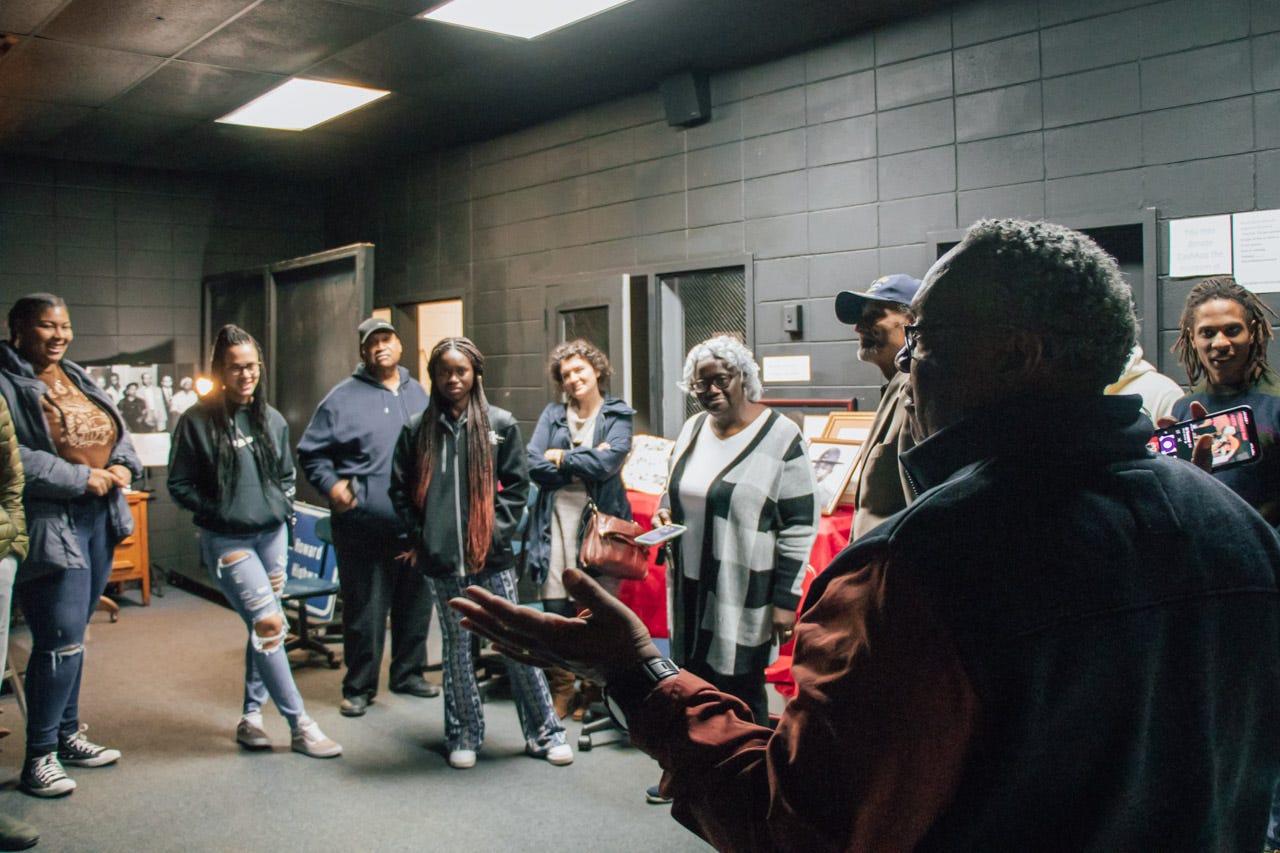

“Talking to the owners was the best part of the entire trip for me.”
Brothers Darryl Johnson and Herman Johnson, Jr. provided a guided tour of the museum and recited the compelling history of Mound Bayou to us. Example after example showcased how the all-Black town developed a reputation for innovation, self-sufficiency, and excellence.
Day 3: The Mississippi Delta
We continued through the Mississippi Delta, traversing six towns that were the locations of significant events and campaigns during the Civil Rights Movement. Our stops included Cleveland, Ruleville, Glendora, Money, Greenwood, and Belzoni.
Fannie Lou Hamer Memorial Garden and Statue
Fannie Lou Hamer is relatively unknown, considering her status as a titan of the Civil Rights Movement. We familiarized ourselves with Mrs. Hamer by watching Fannie Lou Hamer’s America, which tells her story in her own words.


Then we visited the memorial park where Mrs. Hamer and her husband, Pap, are buried to pay tribute to their contributions to the Black freedom struggle. We placed flowers on her grave while Fannie Lou Hamer by Sweet Honey in the Rock played in the background.
“This place felt so holy… It was good to honor Fannie Lou Hamer.”
Emmett Till Historic Intrepid Center
Hon. Johnny B. Thomas, mayor of Glendora and founder of the Emmett Till Historic Intrepid Center, greeted us at a former cotton gin turned museum. Here we learned about Emmett Till’s fateful trip to Mississippi, how he was kidnapped from his uncle’s house, and brutally lynched. We also learned about Mamie Till-Mobley’s decision to hold an open casket funeral for her son.
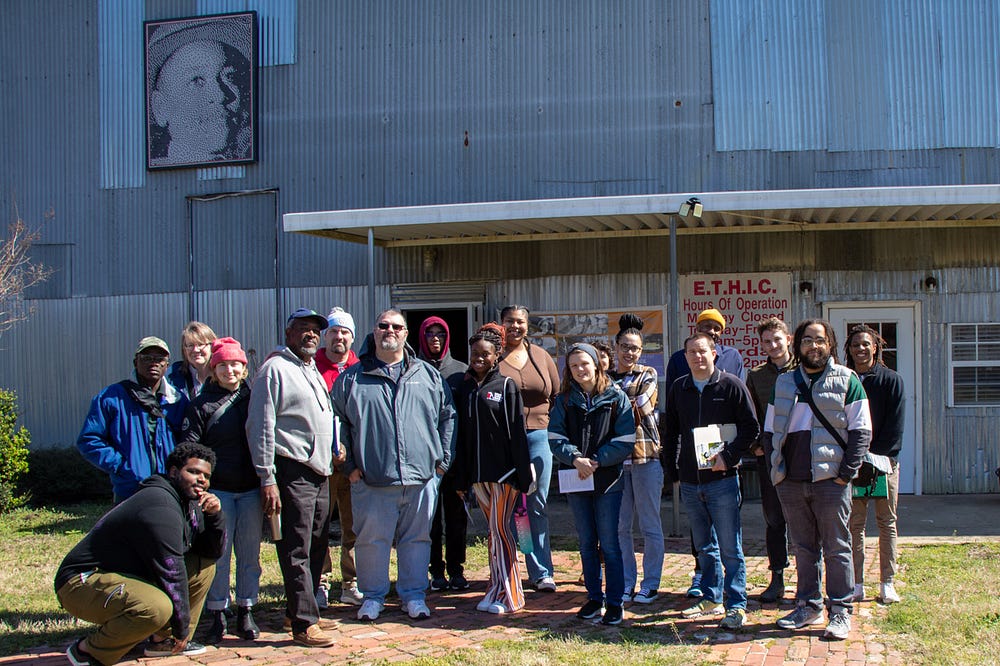
“A most moving experience. To know where you are standing and the dark, ugly history that took place there.”
Money, Mississippi
We also stopped by the site of the former Bryant’s Grocery and Meat Market where Emmett Till allegedly whistled at Carolyn Bryant. Those who own the property have deliberately let the building deteriorate to the point that it is unrecognizable. This site shows the ways that some prefer to forget rather than preserve the memory and narratives of historic sites.

“Seeing [Bryant’s Grocery and Meat Market] helped understand the polarization in keeping the history alive here.”
Historic Wesley Methodist Church
We met with Pastor McKinney and congregants of Wesley United Methodist Church to learn more about SNCC’s various campaigns in Greenwood. While sitting in the pews, we listened to the 1965 Smithsonian Folkways recording “The Story of Greenwood, Mississippi.”
We believe some of the audio tracks on this record were recorded at meetings in this church between 1963–64, and sixty years later, their voices once again reverberated inside these walls.
Greenwood is recognized as SNCC’s first major success in Mississippi. Here we listened to the story told by SNCC staffers and local people who braved police brutality and extrajudicial violence to organize a historic campaign of voter registration as well as food and clothing distribution.
“The audio recording in the church with the living people who had been in the history was very powerful.”


“I loved this church!! The mural in the background was gorgeous! It was really interesting talking to the pastor about the inspiration behind the mural.”
Black Power Speech Historic Marker
Another historic event happened at a park in Greenwood a few years later. During the 1966 Meredith March Against Fear, Stokely Carmichael gave the first official “Black Power” speech during a late-night rally. We visited the historic marker at this location.

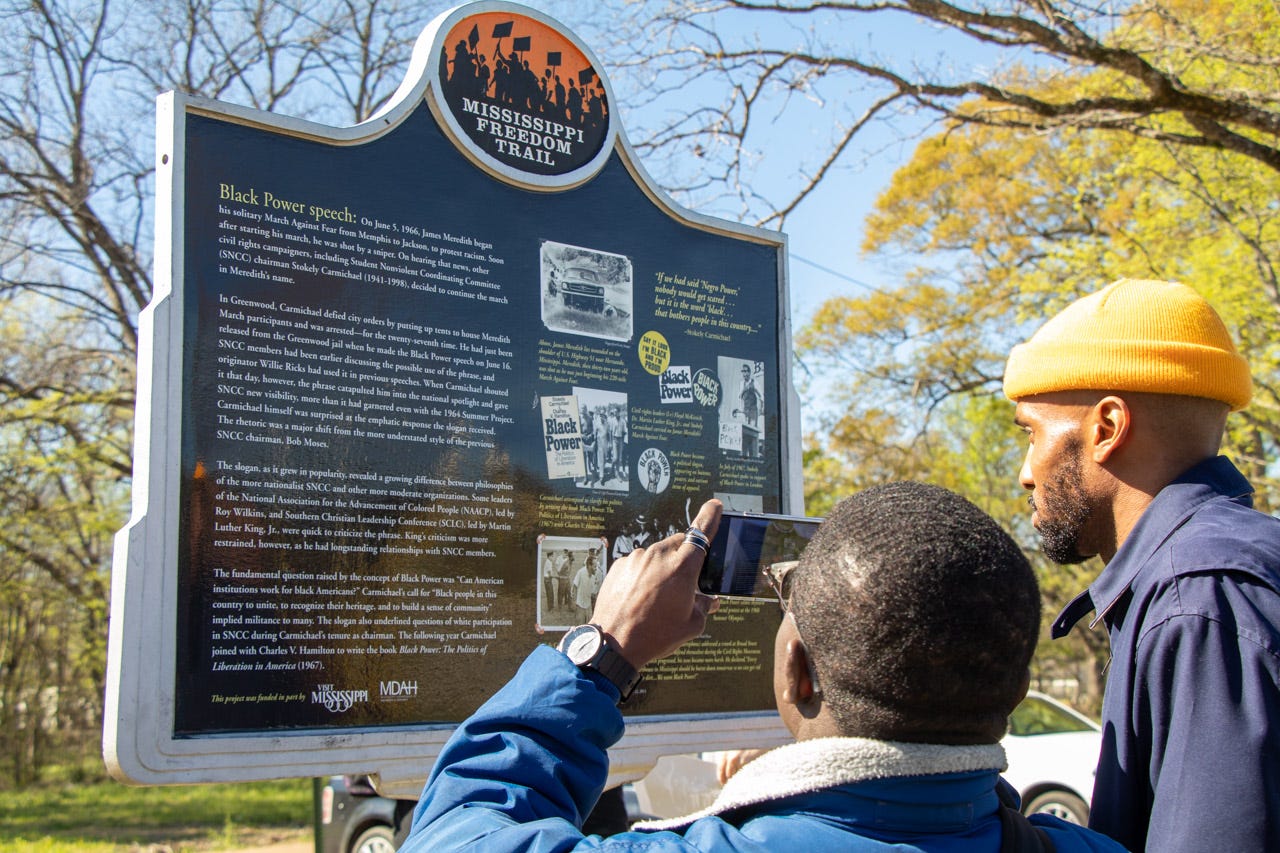
“The state of the environment where the Black Power speech was delivered shows how much work still remains to be done in the country.”
Rev. George Lee and Fannie Lou Hamer Civil Rights Museum
Our last stop in the Delta was the Rev. George Lee and Fannie Lou Hamer Civil Rights Museum, located near the site where Rev. George Lee was killed in 1955, a few months before Emmett Till, for urging Black people to register to vote. Here, the Old Storyteller familiarized us with the storytelling tradition of griots. She weaved together stories passed down from before slavery, stories about Fannie Lou Hamer, and her work to preserve the memory of those who have struggled and sacrificed for Black liberation.
“It felt good to listen to an elder tell the story.”

“The passion of the “Old Storyteller” was moving and also offered moments of levity.”
Day 4: Mississippi Summer Project
We then left the Delta to visit a series of sites that are most well-known for events that took place during the long, hot summer of ’64.
Canton Freedom House Civil Rights Museum
Freedom Houses served as movement hubs in cities where field organizers set up operations. These were places where meetings and workshops took place, where donations were distributed, and where workers and volunteers lived. They were also among the locations most frequently targeted by white supremacists. The Canton Freedom House was operated by the Congress of Racial Equality (CORE). It survived a bombing in 1964 and is not only still standing today, but it has been renovated into a museum.
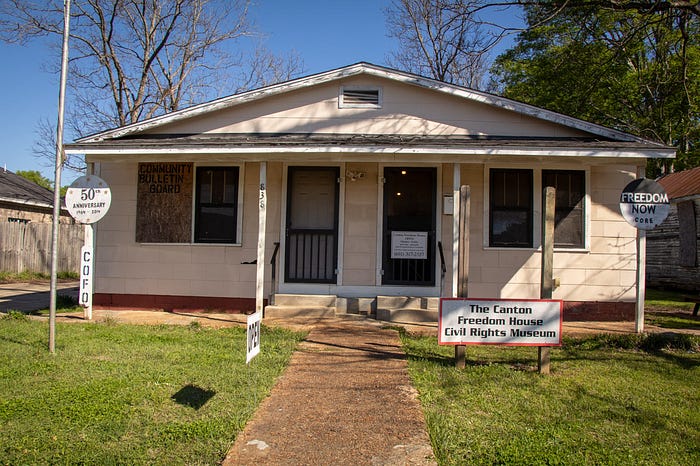
Here we received guided tours from Glen Cotton and Tim Taylor. They taught us the history of the Civil Rights Movement in Canton while we stood in the same place where some of these events happened or were planned.
Among those featured was Anne Moody, author of Coming of Age in Mississippi. She was active in Canton during the civil rights movement and lived and worked at the freedom house for some time.
“The Canton Freedom House blew me away. I felt like I was right in the middle of history — it was more than I expected.”


“…it felt like a living breathing spiritual place, and I was enthralled.”
Mt. Zion Methodist Church
We then made our way to the rebuilt Mt. Zion United Methodist Church in Philadelphia. In 1964 the original church at this site was planned to host a freedom school before it was bombed by white supremacists. Three civil rights workers — James Chaney, Andrew Goodman, and Michael Schwerner — were investigating this incident when they were arrested, kidnapped, and murdered by Ku Klux Klan conspirators, including the local Sheriff.



The case of the missing civil rights workers captured the attention of the nation as it took 44 days to locate their bodies. Several songs were written about this. We played a few of them at this site.
“So important to be here. I felt an overwhelming sadness for what people endured just to make people’s lives better.”
Meridian Civil Rights Trail
We continued to Meridian where we walked through what remains of the African American Business District and the still-operating Kress store that local activists integrated through sit-in demonstrations. At the Lauderdale County Courthouse in downtown Meridian we noticed, on opposite sides of the courtyard, a small Civil Rights Trail historical marker and a large Confederate statue. A passerby said to our group, “That’s a beautiful statue,” as we stood near the base of the confederate statue. We also stopped by St. Joseph’s Catholic Church, where James Chaney went to school and served as an altar boy in his youth.



Site of Meridian’s Freedom School
During the summer of ’64, civil rights volunteers operated a network of alternative schools that taught Black history, civic engagement, and numerous other subjects. Meridian’s freedom school, located at the Meridian Baptist Seminary, was the largest in the state with 200 students and seven classrooms.
While the building is no longer standing today, the legacy of the freedom schools lives on. Here we circled up in the grass field and held a poetry circle, each of us reading a poem from a collection written by freedom school students in the summer of ‘64.
“I loved the freedom school site. It was really neat to see that some of our most pressing history is hidden right under our feet.”

“The poetry at the Freedom School site was beautiful.”
Historic First Union Baptist Church
Meridian community members and congregants of Historic First Union Missionary Baptist Church awaited us as we arrived at the church. This church is best-known as the location where James Chaney’s memorial service was held and where Dave Dennis, Mississippi Project Director of CORE, gave a fiery eulogy that has been recognized as an inflection point in the Civil Rights Movement. Here we sat in the same pews of those who attended his memorial service and listened to an edited audio recording of the service including the full remarks of Dave Dennis and Rev. Ed King.
We also heard from Melba Clark-Payne who shared about her and the church’s prominent role in the Meridian civil rights movement. We then video conferenced with Roscoe Jones, who attended the Meridian freedom school and was elected the first president of the Mississippi Student Union at the freedom school convention held in Meridian. He shared how he was originally supposed to join “J.E., Mickey, and Andy” on their fateful trip to Mt. Zion. He also shared his frustration with how little of the civil rights movement is remembered today and how far we still have to go in the fight for racial justice.


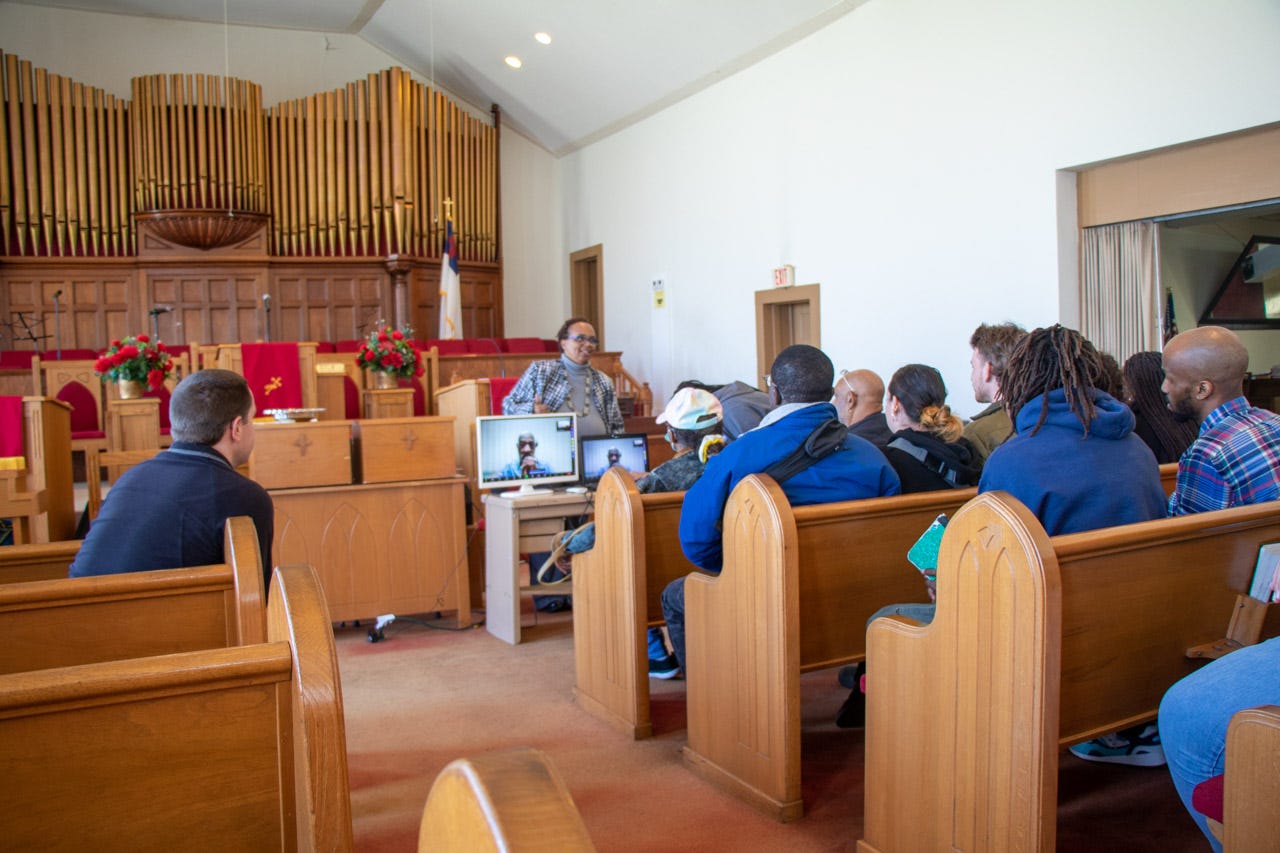
After spending time with the community members who joined us to listen to the memorial service recording and conversation with Roscoe Jones, we visited James Chaney’s gravesite at the Okatibbee Missionary Baptist Church Cemetery.
“THIS was the most powerful part of the trip, for me (church, recording, and gravesite) — I tell people what I learned [on the trip] in the style of Dave Dennis.”

“I felt like we gave James Chaney a deserved honor by visiting his gravesite.”
Day 5: Natchez
Our next stop, located along the Mississippi river in the southwest corner of the state, was a place few of us knew about before arriving. Natchez is one of the oldest cities in Mississippi and the state’s first capital.
Natchez Museum of African American Culture and History
We started and finished the day at the Natchez Museum of African American Culture and History. In the morning we learned about Black life in Natchez and the important and unique role Natchez holds in Mississippi history.



When we returned in the evening, we watched American Reckoning to learn more about activities in Natchez during the civil rights movement. The film is replete with archival footage that features activists from SNCC, NAACP, and Deacons for Defense and Justice. It ties the past to the present by telling the story of the 1967 murder of Wharlest Jackson, Sr. and the reopening of his case due to the 2008 Emmett Till Unsolved Civil Rights Crime Act.
“…the museum was great! I loved looking through everything and the documentary tied everything together nicely.”
Natchez Black Folks Tour
We then embarked on a tour with Rev. Tracy Collins from Rev’s Country Tours. Our first stop was the grounds of Melrose Mansion at Natchez National Historic Park. Here Rev shared how the antebellum economy was built on cotton and slave labor, with Natchez as a major trading port. The wealth generated through exploitation resulted in the extravagant mansions built here. He also shared the more peculiar side of Natchez’s history including how, despite being deep in the South, it remained in the Union throughout the Civil War and avoided the destruction that befell nearby cities like Vicksburg.



We also stopped at Forks of the Road at Natchez National Historic Park, which before the Civil War was the second busiest slave trading market in the south. We gathered around a small monument made of shackles and concrete as Rev shared about the brutality of slavery, the long struggle for freedom, and present-day implications of this chapter in our nation’s history.
“I loved this! Rev… really had a way of making history come to life.”



“The most phenomenal part of our trip. [Rev] made me feel like I was in history and connected the place to the people.”
Day 6: Jackson

The Mississippi portion of our trip then concluded in Jackson where we spent a day exploring civil rights sites in the state’s largest city.

Historic Jackson Greyhound Bus Station
We stopped at the site of the Historic Jackson Greyhound Bus Station, which has been restored to its original art-deco design. This is where more than 430 people were arrested during the 1961 Freedom Rides. Many of those who were arrested were sent to the notorious Parchman Farm prison. Here, we played a few songs from the below playlist that were written about the freedom rides.
“It was interesting to see how different everything is up close versus in pictures. This was one of the most interesting places we visited.”
Smith Robertson Museum & Cultural Center
The Smith Robertson Museum and Cultural Center is located in the historic Smith Robertson School, Jackson’s first public school for Black children. We received a guided tour from Theresa King, who also shared stories of her recollections of being a little girl who got to travel with her activist mother to visit and deliver supplies to various freedom schools in the summer of ’64.


Georgia Cohran also joined us and spoke with several of us about the various exhibits and local history. Among the most striking exhibits here were those that told the story of the Jackson Woolworth’s Sit-Ins by students from nearby Tugaloo College and another about Medgar Evers.
“The story of the building and the experiences of Black people in Jackson helped me understand the history of the civil rights movement more.”


Medgar and Myrlie Evers Home National Monument
We then traversed from downtown into a residential neighborhood to visit the Medgar and Myrlie Evers Home National Monument. Evers was the first Mississippi field secretary for the NAACP and one of the most prominent activists in the state. He was shot and killed in his driveway by white supremacist Byron De La Beckwith when he returned home from a rally on June 12, 1963. Myrlie and their children were inside waiting for him when they heard the gunshot.
“To imagine the incident was both infuriating and painful. To imagine how the shooting happened made me appreciate the freedom that we have now.”


“This was very powerful… walking where [Evers] lived and worked and died was unforgettable.”
Mississippi Civil Rights Museum
Our day in Jackson concluded at the Mississippi Civil Rights Museum. It was neat to see both how much we had already learned about the Civil Rights Movement in Mississippi on our trip, as well as how much more there still is to explore. Among the highlights here were the compelling short films on Emmett Till, educational disparities in Mississippi schools, the murder of Medgar Evers, and the Mississippi Burning case.

“A really neat museum… it is a great place to learn.”
Day 7: Memphis, part two
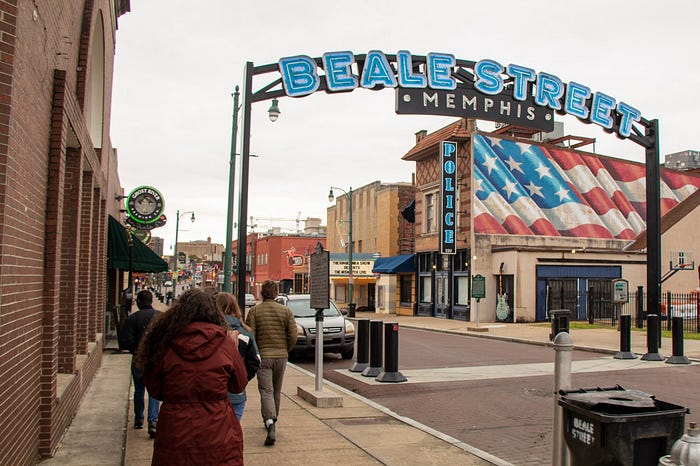
For our final day of activities, we drove north to visit a few more sites in Memphis, TN.
Withers Collection Museum & Gallery
The Withers Collection Museum and Gallery houses the works of photographer Ernest C. Withers, the personal photographer for Dr. Martin Luther King, Jr. Here we browsed the photos on display and arranged to play a video recording of Dr. King’s speech titled “The Other America.” This is known as one of his most radical and prophetic speeches.
“The speech is now my favorite MLK speech.”
“Such a great capstone, a reflective place, some of the words in that speech will stick with me for life.”
Beyond the MLK collection, the gallery highlights Black life and activism in Memphis. They also have a photo wall with a sign bearing the slogan of the Sanitation Workers’ Strike.


“I found the photos really interesting. Many of them I had never seen before. They gave a whole new perspective to some of the parts of the movement that I thought I knew really well.”
I AM A MAN Plaza
Located adjacent to Historic Clayborn Temple, the I AM A MAN Plaza shares a timeline of the Memphis Sanitation Worker’s Strike in 1968. The tribute also includes the names of all the sanitation workers who participated in the strike, which successfully advocated for union recognition and wage increases.
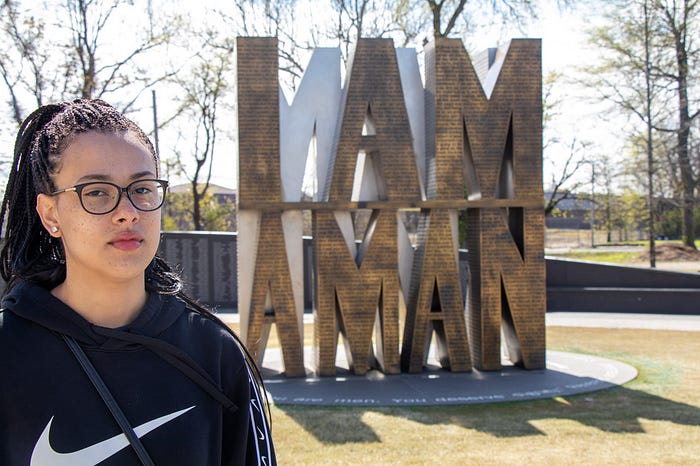
“The I AM A MAN Plaza helped provide more information about the incident leading to the murder of MLK.”
Rock ’n’ Soul Museum
The Memphis Rock ’n’ Soul Museum explores the birth of the blues and its evolution into rock ‘n roll. Recording studios like as STAX provided a platform for collaboration between white and black artists, bringing people together through their love of music. The museum’s self-directed audio tour included access to over 100 songs — listed in era-appropriate antique jukeboxes — which reflect how times have changed, or how music has influenced social change.



“So much valuable knowledge, and great to get some history behind the music we heard throughout the trip.”
Returning Home
We then made our way back to Milwaukee, reflecting along the way about our experiences over the past week. Below are some more of the reflections:
“This has been my favorite experience at Marquette by far. I will be suggesting this trip to anybody with any curiosity of American history, because at the end of the day, this trip was the basis of all American History.”
“I learned so much from my peers. They instilled a sense of community that will make this spring break trip last a lifetime in my memories.”
“I am glad that the trip focused on the rural areas where it happened instead of just museums. The conversations with the museum curators and local people also helped to teach about the history.”
“[The trip] exposed some really important history, and I came to my own understanding about why that history is invaluable.”
“[The music] was pitch perfect and added so much to the pilgrimage.”
“This trip has helped me realize that my ancestors were strong and didn’t allow adversity to get in their way. This will shine in my everyday life.”
“I felt like this was the most transformational experience I’ve had at Marquette. I was able to consider how I fit in — at Marquette, in Milwaukee, and in my country.”
“I will be talking about this for a long, long time.”
“[The pilgrimage] made me feel a sense of responsibility to always contribute to every attempt to make the world better.”
The trip impacted us all in different ways. Likewise, resistance during the Civil Rights Movement took many different forms. Each activist contributed to the movement in ways that reflected their unique talents, resources, and location.
As movement veteran Roscoe Jones shared with us in Meridian, these varied contributions were united by a deeper commitment to freedom — a full and total commitment. This, he indicated, is both the path forward and the best way to honor the history of this struggle.
